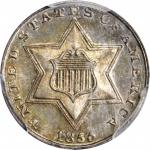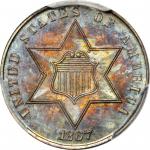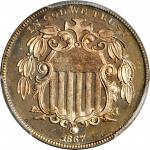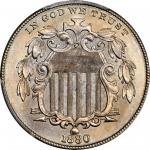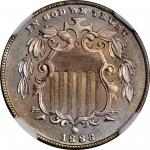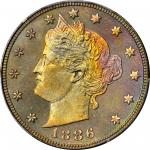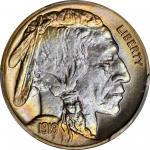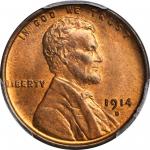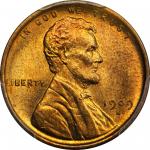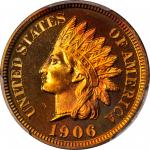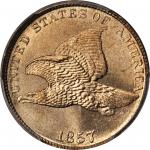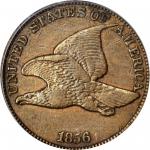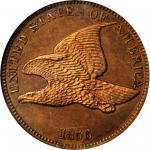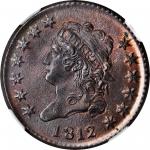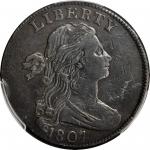1983-D Lincoln Cent--Struck on a Bronze Planchet--AU-55 (PCGS).3.10 grams. This planchet error is similar in nature to the 1943 Copper cents and occurred in precisely the same manner. The 1983-D copper planchet cents are destined to remain quite rare as the change from the old tenor copper (also known as bronze or brass) planchets to the new 97.5% zinc and 2.5% copper planchets occurred in October of 1982 at the Denver Mint, at least two months before 1983-D cents were struck. Quality control was also very high at the Denver Mint in this time period, undoubtedly leaving few such errors to be discovered.Cents in America had planchets primarily of copper since they first appeared in general circulation in 1793, save for a few exceptions detailed below. After 189 years inflation forced change. 1982 saw the end of copper as a primary metal used in the cent, and the change was made to a zinc planchet with thin copper plating to give the appearance of the old style cent. This planchet blend continues in use today.Considerable satiny luster remains across both sides of this unique rarity, complemented by traces of mint-red haloing the design elements in select regions. The devices exhibit bold definition and the rims remain nicely sharp, with evidence of friction confined to just the very highest points. Magnified inspection reveals only trivial scattered marks throughout the fields commensurate with the assigned grade. A short and shallow mark hides between the first two digits of the date, though this is insignificant. The strong technical and aesthetic merits enhance the numismatic significance of this unprecedented error.How these transitional planchet errors came to exist has been well researched by following the planchets from the time they were stamped out of the copper sheets through the coining process. Large steel tote bins are used to transport the blank planchets to the coining presses where they can be dumped into hoppers that feed into the coining presses. These tote bins carry a lot of weight, and the bins steel welds and seams sometimes crack, allowing a few planchets to become trapped or lodged in the cracks and seams. Once the coins are struck, they might be returned to the same or another tote bin and moved to the counting, bagging and shipping area. Thus a handful of these older copper planchets must have remained stuck in one of the tote bins, staying there for at least four months (October 1982 until January 1983 or later). They somehow became dislodged from the seam and fell into the hopper and were struck with a new batch of lighter weight planchets.The price of copper has risen and fallen over time. History records times when copper prices threatened production of the copper cent, as the cost of the metal approached and even exceeded the face value of the coin being struck. In 1943 all copper that could be obtained was needed for the war effort resulting in the 1943 zinc-plated steel cents, then the 1944 and 1945 cents made from recycled gun shell casings more in keeping with the traditional bronze cent composition. The next minor change came in September of 1962 when a shortage of tin (used in the French bronze alloy at 2.5% of the composition) became expensive, so it was dropped and Lincoln cents became brass, with a blend of 95% copper and 5% zinc. In 1974 there was another price increase in copper, at a time when the West Point Mint began coining cents (without mintmarks, mintages lumped in with Philadelphia). An experiment was launched to strike the 1974 Lincoln cents on aluminum planchets. A total of 1,579,324 aluminum cents were struck with all but a few apparently destroyed. At least one resides in the Smithsonian in the National Numismatic Collection. Other 1974 aluminum survivors are reported, but are still subject to seizure as having escaped the mint without authorization.Discovered several years ago while our consignor Jeff Young was searching through rolls of cents, this 1983-D cent struck on a bronze cent planchet remains unique, making it rarer even than the 1974 experimental aluminum cents. Young found the coin after reading Ken Potter and Dr. Brian Allens book <em>Strike It Rich With Pocket Change</em> (3rd Edition) in which the possible existence of a 1983-D Bronze cent was alluded to in a footnote for the 1983 Philadelphia Bronze cent, discovered by the late Billy Crawford and which was also included in the book. After finding the coin Young contacted Potter and drove it from Ohio to Michigan for Potter to authenticate and photograph it. Its existence was first revealed in a front page <em>Numismatic News </em>story by Potter in January 2013. Potter indicated that he has not heard of another example in spite of the fact it was given a full page treatment in the 4th Edition of <em>Strike It Rich</em> published in 2013.Given tighter quality control at the Denver Mint from the 1960s through at least the 1980s, it is not surprising that the 1983-D bronze cent is much rarer than the 1983 Philadelphia Mint cents in bronze, of which several are known and have commanded low five figure realizations in recent years. When Young learned of the consignment of the unique 1982-D Small Date cent in bronze to this auction, he thought it was the perfect opportunity to offer his coin to the marketplace. Here is a second chance for a modern error collector or Lincoln cent enthusiast to acquire a unique and truly significant transitional error.


